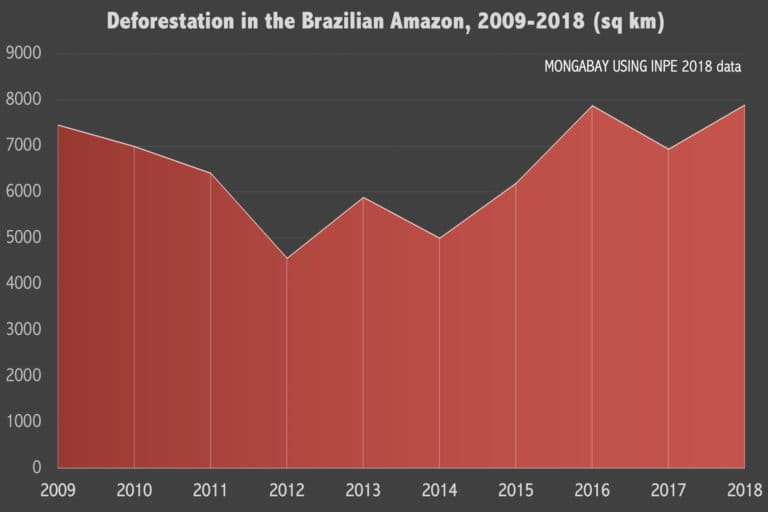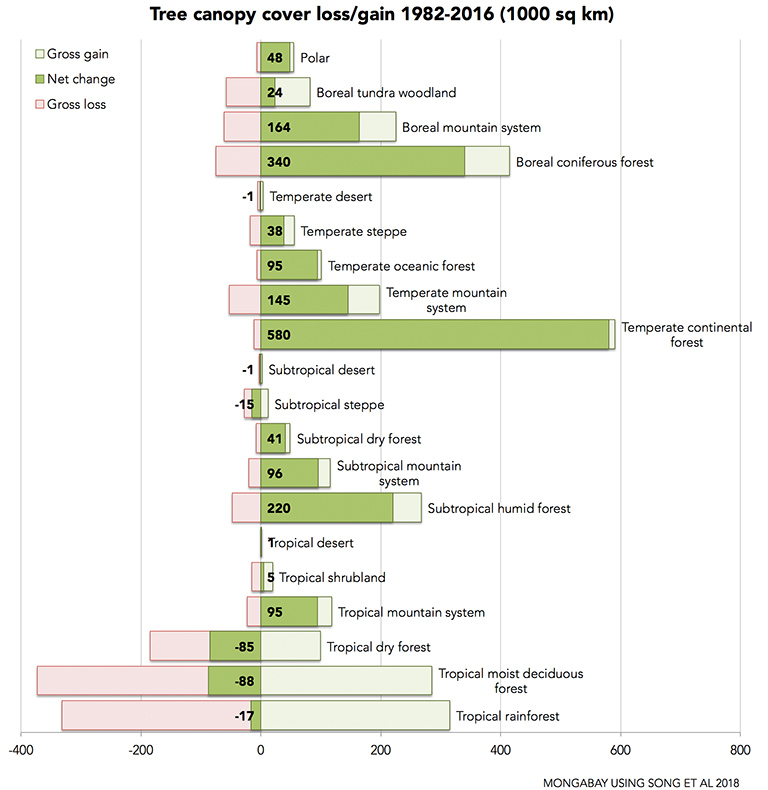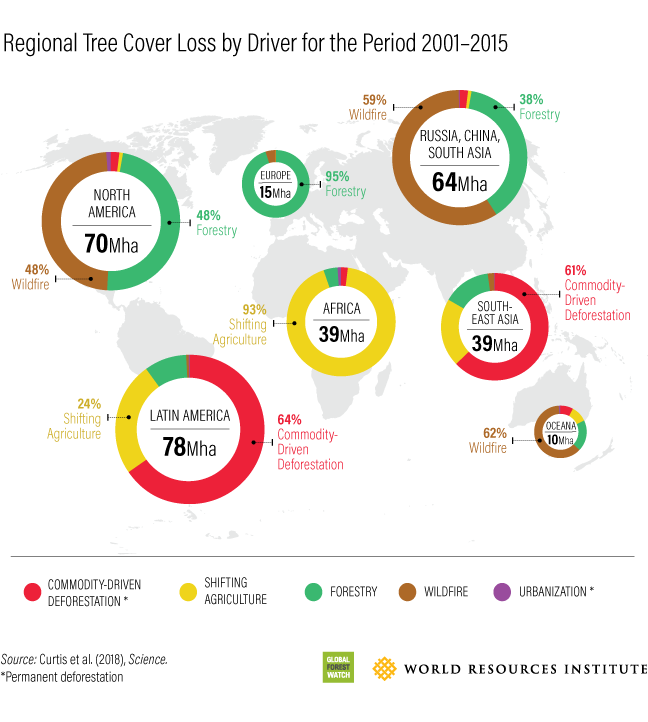- This is our annual rainforests year in review post.
- Overall, 2018 was not a good year for the planet’s tropical rainforests.
- Rainforest conservation suffered many setbacks, especially in Brazil, the Congo Basin, and Madagascar.
- Colombia was one of the few bright spots for rainforests in 2018.
2018 was a difficult year for the world’s tropical rainforests. Below are of some of the biggest rainforest storylines for the year, but we couldn’t cover everything, so if there are important things missing, feel free to add them via the comment function at the bottom.
The outlook for 2019 will be covered in an upcoming post: Rainforest storylines to watch in 2019 [1/2/19].
Summary
With rising deforestation and/or the election of anti-environmental administrations, things went generally downhill for rainforests in Brazil, Democratic Republic of Congo (DRC), and Madagascar.
Peru had a mixed year for rainforests, declaring a huge new national park, but also having some conservation setbacks. Indonesia had some bright spots between last year’s decline in deforestation, a three-year renewal — and strengthening — of a palm oil moratorium, and the release of One Map.
Malaysia‘s rainforests did even better with new conservation areas and a log export ban in Sabah and a conservation commitment from Sarawak (albeit unlikely to be met). But Colombia led major rainforest countries in terms of positive developments, with outgoing president Juan Manuel Santos working to leave a conservation legacy.
Outside the tropics, Trump Administration undermined rainforest conservation between his trade war with China that boosted the profitability of deforestation for commodity production in the Amazon; his attacks on science, scientific institutions, and intergovernmental bodies; and his tacit approval of regimes that murder journalists, human rights advocates, and environmental defenders. Europe was more supportive of rainforest conservation with various initiatives to eliminate or reduce deforestation from commodity supply chains, and Norway continued to lead the world in funding efforts to protect forests across the tropics.
Commodity markets — especially palm oil — had a rough year, resulting in strengthening of sustainability commitments and standards, as well as reducing profitability of expansion in many markets (trade wars aside) and possibly offering a bit of respite for rainforests following two years of historically high forest loss.
Two studies published in 2018 offered very bad news for orangutans (150,000 dead in 15 years) in Borneo and good news for great apes in Africa (chimp and gorilla populations are higher than expected). But overall, biodiversity probably lost more than it won during the year.

Brazil
Home to nearly two-thirds of the world’s largest tropical rainforest, developments in Brazil are globally significant to rainforests. And 2018 had no shortage of major developments in Brazil.
The year started out on a relatively positive note for Brazil’s forests and indigenous peoples, with a top official at the Ministry of Mines and Energy announcing an end to the era of building big hydroelectric dams in the Amazon basin and the government releasing data showing that soy farming in newly deforested parts of the Amazon had slowed dramatically. But that positive news was overshadowed by Brazil’s ongoing political corruption crisis, its struggling economy, and remote sensing data which seemed to indicate an upward trend in Amazon forest loss.
In February, Brazil’s supreme court ruled that changes to the country’s forest code, which governs land use in the Amazon and beyond, were constitutional, raising fears among environmentalists that the country’s environmental protections could be further weakened.
In April, an investigation found that members of Congress were receiving millions of dollars in campaign funds from entities convicted of deforestation crimes. “Of the 249 deputies who received tainted donations, 134 are members of the Bancada Ruralista, the pro-agribusiness rural caucus that dominates the chamber,” noted a Mongabay story. Investigations published later in the year revealed rampant fraud in the timber permitting systems, effectively allowing loggers to evade taxes and regulations; six members of the bancada ruralista agribusiness lobby of congress had been charged with, or convicted of crimes; and the use of offshore tax havens by major soy and beef producers. A Starbucks supplier was linked to slave labor in the Amazon, while a top U.S. flooring retailer was tied to Brazilian firm ensnared in timber bust. IBAMA, the Brazil’s environmental law enforcement agency levied $29 million in fines on major soy traders and farmers for illegal deforestation.
Donald Trump’s trade war with China fueled a sharp increase in Brazilian agricultural exports, increasing the profitably of agribusiness and raising concerns about accelerating deforestation. While the Temer administration announced that Brazil had already met its 2020 emissions reductions target, scientists and analysts warned that rising deforestation could cause the country to miss that goal. In fact, Brazil’s deforestation rate in the Amazon has exceeded its target the past four years running, raising the prospect that Temer’s celebration may have been premature. When Brazil released its official deforestation tally in late November, it showed that deforestation had reached a ten-year high. (By contrast, cerrado deforestation fell).
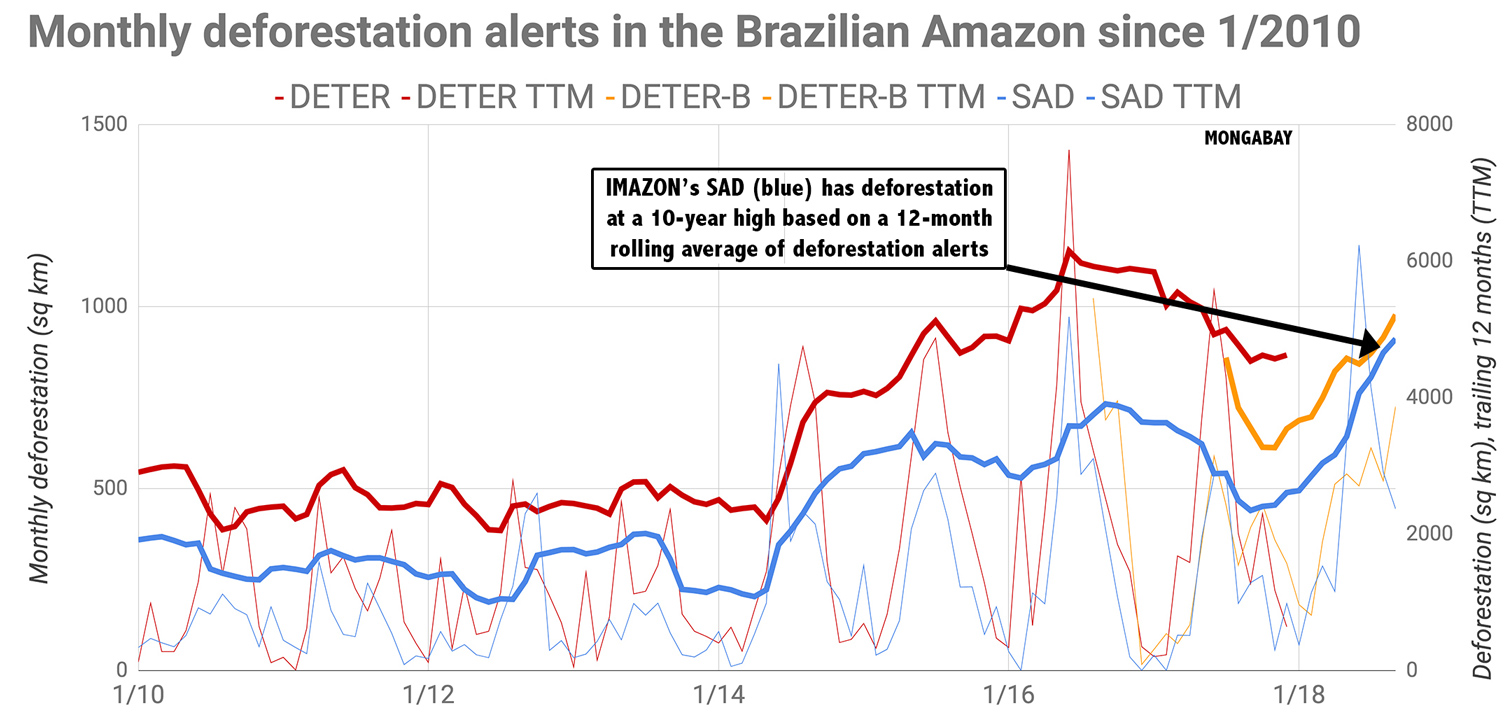
The apparent reversal in the deforestation trend was enough to cause Norway, the chief foreign patron of the Amazon Fund, to voice concern as it paid another $70 million into the conservation fund.
In September, the Ministry of Justice formally recognized the 2.1 million hectare Kaxuyana-Tunayana indigenous territory on border of Pará and Amazonas, But later that month, Congress stripped protected status from 11 new conservation areas covering 600,000 hectare in the state of Rondonia.
The biggest development for the near-term future of the Amazon came in October with the election of Jair Bolsonaro, a populist who championed himself as an anti-environmentalist, calling for measures to strip indigenous peoples of their traditional lands, curb environmental protections, and pull Brazil out of its international climate commitments. The run-up to the election was marred with violence and warnings from scientists that Bolsonaro could undo much of the progress Brazil has made in the past decade and undermine its international leadership on climate and forests. Civil society grounds scrambled to figure out how to engage with the new administration.

Palm oil
While palm oil has been one of the biggest drivers of deforestation for over a decade, 2018 seemed to be the year that palm oil finally caught the world’s attention.
A slew of scientific studies and NGO reports (including a bombshell expose by Greenpeace) added further detail on the impact palm oil is having on the world’s forests, but it was an ad campaign by Iceland Foods, a British supermarket, that emerged as one of the biggest catalysts for global awareness around the crop. It started in April when Iceland announced it would remove palm oil from its own-brand products. That announcement was followed by the customary denunciations by the palm oil lobby as well as calls for palm oil boycotts by fringier environmental campaigners (Greenpeace noted that it was against deforestation, not palm oil). The situation got interesting when Iceland repackaged an animated short that had originally been produced by Greenpeace. The video told the story of a young orangutan forced to leave its home due to destruction of its natural habitat for palm oil production. Clearcast, the U.K. organization charged with approving advertisements before they air, barred the ad from running due to its “political” nature. That ban was marketing gold for ad, leading it to go viral across social media and raising global visibility on issues around palm oil. Google Trends data shows that global interest in palm oil — as measured by Google searches — peaked around the time of the ad ban.
Beyond the Iceland ad ban, there were plenty of other developments on the palm oil front. Most notably, the global energy slump significantly affected the palm oil market, driving the palm oil price to the lowest levels more than a decade. The price drop put major buyers in a position to demand higher production standards, which translated to import restrictions in Europe and added pressure on the Roundtable on Sustainable Palm Oil (RSPO) to adopt a zero deforestation standard, which it did in November. In an attempt to establish a price floor, the governments of Indonesia and Malaysia moved forward with biofuels mandates (B20 biodiesel mandate in Indonesia; B10 mandate in Malaysia) to create new sources of demand for palm oil.
The world’s largest palm oil company Wilmar got caught up in a scandal when Chain Reaction Research revealed it was using shadow companies to cirumvent its zero deforestation commitment. The scandal prompted Wilmar co-founder Martua Sitorus to resign. Wilmar sought redemption by announcing stronger palm oil sourcing criteria, although critics said the new policy still lacked transparency.
The Norwegian government banned biofuels linked to deforestation. Meanwhile the U.S. government was called out for contributing to global deforestation through its biofuels mandate. Malaysia and Indonesia protested restrictions on palm oil.
Nestle was briefly suspended by the RSPO in a dispute over paying its membership dues. It was later reinstated. Nestle also announced it would use a new satellite monitoring service developed by Airbus and The Forest Trust to monitor compliance with its zero deforestation commitment for palm oil sourcing.
A study published in the journal Nature Communications calculated the full carbon cost of land use change associated with converting forests to oil palm plantations. The research, which accounted for both above-ground and below-ground carbon, estimated that each hectare of rainforest converted to oil palm monoculture generates 174 tons of carbon emissions, which is a higher figure than used by institutions like the RSPO and IPCC.
In January 2018, the Indonesian government released a new draft of the Indonesian Sustainable Palm Oil Standard (ISPO) certification, which will become a mandatory standard for producing palm oil in the country. Observers like Chain Reaction Research note however that IPSO standard is far weaker than other standards like the RSPO. Despite the weaker standard, it appears small farmers — who are expected to come into compliance by 2020 — are far behind in meeting IPSO criteria.
Several reports detailed how the palm oil industry is pillaging Papua, the Indonesian-held half of the island of New Guinea. Investigative reporting revealed how a 2,800 square kilometer plantation project got granted across community forest lands.
After a long-running campaign by the Rainforest Action Network, PepsiCo suspended buying from an Indofood subsidiary over deforestation and human rights abuses. Activists signaled they are going to step up campaigns against financiers of the palm oil industry and other sectors associated with deforestation.
And finally an artist found a creative way to protest palm oil linked to deforestation, carving an “SOS” message in a plantation.

Zero deforestation commitments
As we approach 2020 deadlines for commitments to reduce deforestation, there is increasing discussion about whether companies are effectively moving from commitment to action on their zero deforestation policies. Several firms had high profile stumbles in 2018. Wilmar and Asia Pulp & Paper (APP) got caught up in controversy when it was revealed that they were using shadow companies to circumvent their sustainability policies. Wilmar suffered resignations of two top executives, including a co-founder over the issue. But the cost for APP was much higher: the pulp and paper giant lost a partnership with Greenpeace that had bought it considerable goodwill internationally and saw its efforts to regain eco-certification under the Forest Stewardship Council (FSC) derailed.
FSC also found itself facing renewed criticism. In March, the eco-certification body lost Greenpeace, one of its charter members. Then in May, an analysis revealed that timber concessions certified by FSC lost more blocks of intact forests than non-certified concessions. In September, FSC said it would conduct further investigation into allegations against Korindo, which environmentalists have linked to large-scale conversion of rainforests in Indonesia.
Like FSC, the Roundtable on Sustainable Palm Oil (RSPO) also faced some headwinds in 2018, including several critical reports and academic papers. Particularly significant was a demand to strengthen its standards from a group of institutional investors representing over $6.7 trillion in assets under management. The letter, which was organized by Ceres, called into question the relevance of RSPO given that the body’s certification criteria didn’t include a zero deforestation component at a time when most of the planet’s major palm oil buyers, traders, and producers had zero deforestation policies. RSPO subsequently established a zero deforestation provision at its November general assembly.
Under pressure from environmental groups — notably campaigns by Mighty Earth — major players in the cacao and rubber industries took steps toward eliminating deforestation from their supply chains.
The effort toward establishing subnational jurisdictional approaches to addressing deforestation from commodity production continued to inch forward under the Governors Climate and Forest Task Force. Supporters see the approach as a means to scale zero deforestation commitments at district, state, and regional levels. For example, Ecuador reactivated its Jurisdictional RSPO Certification plan for palm oil in March 2018, aiming to certify entire provinces rather than individual companies or plantations.

Indonesia
In January, the Indonesian government touted a sharp drop in deforestation, but the figures were immediately contested because they included loss within industrial plantations, which critics say cloud the numbers. However, data released later in the year confirmed a significant decline in both tree cover loss and deforestation.
In July, the Indonesian government launched its first “State of Indonesia’s Forests ” report in collaboration with the U.N. Food and Agriculture Organization (FAO) and Norway’s International Climate and Forest Initiative. The report aims to provide a comprehensive assessment of Indonesia’s forests on a regular basis.
The use of “shadow companies” by major plantation conglomerates to evade zero deforestation commitments was a major theme in Indonesia in 2018. Both Asia Pulp & Paper (APP) and Wilmar — high profile zero deforestation commitment companies — got caught using subsidiaries, affiliates, and sister companies to continue clearing peatlands and high conservation value forests. Their responses were markedly different however. Two of Wilmar’s top executives — including a co-founder — resigned in the aftermath of the scandal. Wilmar then strengthened its sustainability standard and revised its platform for mapping its suppliers. In contrast, APP issued demonstrably false denials and saw Greenpeace terminate its engagement with the fiber giant. The eco-certification body FSC then suspended APP’s process for re-association. Other lower-profile conglomerates were also outed for their use of shadow companies including The Salim Group, which controls IndoFood and First Pacific.
A plan to build a dam that would flood a significant block of habitat for the world’s mostly recently discovered ape species was a top story in 2018. Scientists and environmentalists alike condemned the scheme as a danger both to the Tapanulii orangutan and to people living below the dam site. In August, the Indonesian Forum for the Environment (Walhi) filed suit against the North Sumatra provincial government for approving the project.
Indonesia’s peatlands continued to attract a lot of attention in 2018. Early in the year some 125 palm oil and pulp companies committed to restore a combined 14,000 square kilometers of degraded peatlands that fall within their concessions under a government-led effort to prevent a repeat of the 2015 peat fire crisis. The primary intervention under the program involves blocking drainage canals. In February, a team of scientists from Indonesia, Germany and the Netherlands won the $1 million Indonesian Peat Prize for developing a fast, accurate and cost-effective way to map Indonesia’s peatlands. Both developments are notable given the degree to which peatland restoration efforts are underfunded in Indonesia, according to a study published in Case Studies in the Environment, which estimated that only $200 million of the $4.6 billion needed to restore some 20,000 square kilometers by 2020 has been raised.
Indonesia’s Peatland Restoration Agency was reported to be looking at the possibility of developing swamp-friendly agriculture in the peatlands degraded by the failed Mega Rice Project (MRP). The aim would be to rehabilitate some 1,250 square kilometers to the extent that the area no longer burns during the dry season.
Ahead of the Asian Games, which was being hosted in August by Palembang (South Sumatra) and Jakarta, the Indonesian government enlisted the help of plantation companies to avoid another haze disaster in the midst of the sporting event. The government asked on pulpwood and oil palm companies with concessions in fire-prone areas accelerate efforts to restore degraded peatlands and prevent fires during the June-September dry season. But the push failed to stop the recurrence of fires, with more than 2,200 fire hot spots recorded across Indonesia by mid-August, though the burning and air pollution wasn’t as severe as 2015.
South Korean-Indonesian forestry company Korindo found itself in trouble for breaching its own moratorium on deforestation in its oil palm holdings. The NGO Mighty Earth found that the company has continued to plunder pristine forests in Papua for palm oil and timber. But it wasn’t only Korindo feeling the heat in Papua — at least 17 people — it’s unclear how many were construction workers or members of the Indonesian military — were killed on a stretch of the Trans-Papua highway on December 2 by the National Liberation Army of West Papua (TPNBP), a group fighting for West Papua’s independence. Additionally, an in-depth investigation into the Tanah Merah project (disclosure: this was a joint investigation involving Mongabay), a giant oil palm plantation under development in Papua province, revealed the murkiness of the transactions underpinning the land deal.
Corruption in Indonesia’s natural resources sector continued to loom large in 2018. Another collaborative investigation between Mongabay, The Gecko Project, and Earthsight documented the corrupt sell-off of land and resources by politicians in Central Kalimantan. It also looked at the Corruption Eradication Commission’s (KPK) efforts to take action against corruption in the plantation sector, including obstacles the agency faces in doing its job.
A study by Forest Watch Indonesia found that selective logging concessions accounted for the highest rate of deforestation in three provinces studied from 2013 to 2016. The researchers attributed the phenomenon to illegal encroachment of oil palm plantations and overharvesting of timber.
The fate of the Harapan rainforest conservation project is at stake with the Danish government indicating it won’t renew funding at the end of 2018. The Danish government had hoped the project would develop other funding sources, including ecotourism and trade in non-timber forest products, but that hasn’t happened. The project had been an experiment as an ecosystem restoration concession (ERC), which pays fees and taxes like a logging concession but doesn’t generate logging revenue. Originally it was thought such projects, which aim to restore heavily degraded areas into healthy forests, could generate returns from carbon credits, but that market never materialized. Without Danish funding or another source of revenue, Harapan is expected to be cleared within five years.
In December, the Indonesian government launched a long-awaited database of all government land use maps to eliminate disparities between the various maps currently used by different agencies. The “One Map” initiative, which was launched in 2011 and was slated for completion by 2015, aims to reduce disputes over land use, especially the issuing of permits for mining, plantations, conservation, and community lands. However the newly released map still has some important gaps, including the exclusion of indigenous territories, and surfaced some 10.4 million hectares of overlapping land use in Kalimantan and 6.4 million hectares on Sumatra. Eventually the “One Map” could help address concerns about issues like the government’s proposed “land swap” process, which allows companies with holdings on sensitive peatlands to exchange for concessions in “degraded” forests. NGOs, companies, and local communities fear that the lack of transparency in the process could lead to perverse outcomes, like opening up high carbon stock forests to conversion for plantations or exacerbating social conflict. The unified map could give all parties a more common understanding of the land involved in these swaps. Another issue NGOs hope the map could help address is lack of disclosure around plantations. NGOs that have tried to increase transparency around land use in Indonesia by creating their own maps like Global Forest Watch and Greenpeace have often found themselves in the crosshairs of various ministries.
Indonesia and the European Free Trade Association (EFTA) signed an agreement that eliminated tariffs and non-tariff barriers for thousands of products traded between Indonesia and the EFTA member countries (Switzerland, Liechtenstein, Norway and Iceland). Indonesian palm oil would get nearly full market access in Iceland and Norway, while Switzerland would maintain some quotas on the product. The Norwegian government has separately set zero deforestation standards for its own procurement policies.
Indigenous communities and rights groups expressed dismay about the Indonesian government’s slow progress on passing legislation that would recognize local communities’ land rights as mandated by a 2013 constitutional ruling.
In September, President Joko Widodo issued a presidential instruction extending a moratorium on new licenses for oil palm plantations for three years. The moratorium applies both to new permits and to projects that have yet to secure all the permits needed to begin operating. It also requires a review of oil palm licenses in the country.
In February, Indonesia became the first government to issue a “green” Islamic-compliant bond, or sukuk, raising $1.25 billion. The funds will finance projects that meet environment criteria and are compliant with Islamic financing laws. On the other end of the finance spectrum, in May Chain Reaction Research called out Lembaga Tabung Haji, a major Islamic financier, for deforestation by its publicly traded palm oil company TH Plantations. The company has lost about half of its value since the report came out amid a broad decline in the value of palm oil companies.
In Indonesian courts there were some decisions with significant implications for sustainability. In May, a typo derailed a landmark ruling against an Indonesian palm oil firm found guilty of burning peatland and orangutan habitat in Sumatra. The district court shielded PT Kallista Alam from a Supreme Court ruling ordering it to pay $26.5 million in fines. The verdict stunned activists who saw the case as setting important precedents. In December, judges at the Cibinong District Court in West Java province threw out a lawsuit against Basuki Wasis, an environmental expert, whose testimony was instrumental in the conviction of Nur Alam, the governor of Southeast Sulawesi province, who was charged with abuse of power in his issuance of mining licenses.
Technology
Block chain mania reached the conservation sector, with the technology being proposed as a solution for issues ranging from commodity supply chain tracking to tackling the illegal wildlife trade to raising money for conservation projects. Tech companies like Google and Microsoft put resources toward helping conservationists leverage artificial intelligence (AI) for applications ranging from automated species identification to predicting poaching before it happens to monitoring deforestation. Remote sensing technologies continued to advance, with entities from Planet to World Resources Institute’s Global Forest Watch rolling out new tools to track and anticipate forest degradation and deforestation.
Despite the Trump Administration’s ongoing assault on climate science, NASA was able to launch the global ecosystem dynamics investigation (GEDI) instrument on a two-year mission. GEDI uses Lidar to create 3-D maps of the forests to measure carbon. And the E.U. also pushed innovation in forest monitoring by making cloud-penetrating radar imagery of the whole planet freely available.
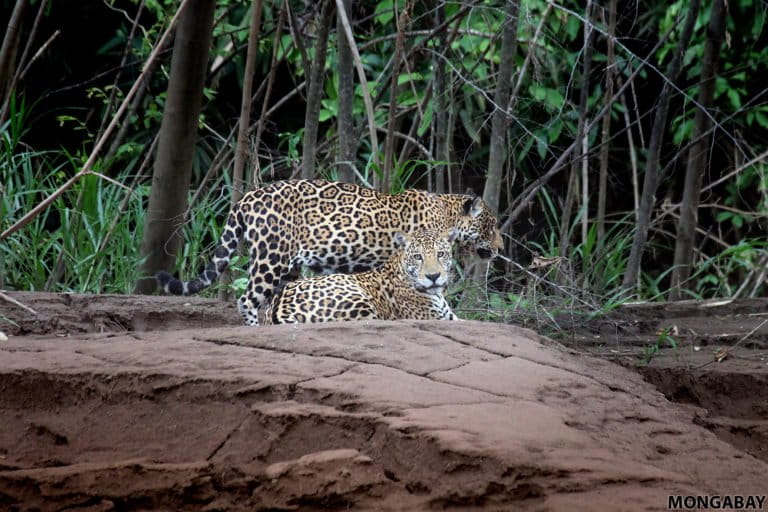
Peru
The pope’s visit to the Peruvian Amazon in January put a spotlight on deforestation and indigenous peoples rights. His trip was preceded by the long-awaited declaration of Yaguas National Park, a protected area around the size of Yellowstone National Park that covers more than 8,680 square kilometers of rainforest and is home to upwards of 3,000 species of plants, 500 species of birds and 160 species of mammals. But just following the pope’s departure, the Peruvian government approved a law that would allow roads to be built in border zones of “national priority and interest”, effectively opening up the country’s most remote and pristine areas to deforestation, logging, and mining. The Amazon Conservation Association’s Monitoring of the Andean Amazon Project (MAAP) estimated the decision would put 2,750 square kilometers of primary rainforest at risk, while threatening indigenous communities.
Research showed that gold mining in the Peruvian Amazon has reached a all-time high and that illegal logging and timber smuggling continue to plague the country’s forestry sector.
On a more positive conservation front, other research found that ecotourism in Peru’s protected areas generated $720 million dollars in revenue and created 36,000 jobs in 2017.
Peru established a special judiciary on environmental crimes to deal with backlog of some 20,000 complaints ranging from small-scale illegal mining up to governor-level abuses. But in December, Peru’s timber watchdog agency OSINFOR was merged into the Ministry of Environment, sparking sharp criticism from NGOs and the U.S. government. The move appeared to breach Peru’s trade agreement with the U.S., which required independent oversight of the timber trade.
Biodiversity
From orangutans (Borneo alone lost nearly 150,000 since 1999) to birds (eight extinctions confirmed this century) to insects (Puerto Rico’s rainforest registered a 60-fold decline), a number of studies published in 2018 added to the growing body of evidence that we’re in the midst of the planet’s sixth great extinction. Summing up the trend, WWF’s latest Living Planet Report estimated that the number of vertebrate animals per species has fallen by 60 percent on average since 1970.
Despite the long-term trend, there were a few bright spots for biodiversity in 2018. The critically endangered Sumatran rhino got a lifeline in the form of a $20 million commitment to stave off its extinction, while initiatives aiming to set aside up to half the planet’s land area for nature gained momentum. The U.N. worked to reignite interest in global targets to protect biodiversity.

Forests’ role in climate change mitigation
Advocacy campaigns like The Forgotten Solution coupled with prominent reports and studies raised the profile of tropical forest conservation as a climate change mitigation strategy. Beyond the solutions framing, much of the focus in 2018 was around tropical forests shifting from a net carbon sink to a source of emissions due to rising rates of deforestation and forest degradation, increased incidence of forest fires, and ongoing destruction of peatlands. Several studies warned about trends in Earth’s largest rainforest, the Amazon, which is experiencing more droughts and fires. Scientists continued to express concern about the Amazon reaching a tipping point where vast areas of rainforest are replaced with savanna. Even swampy, carbon-dense Amazon peatlands are at risk. Overall, emissions from tropical deforestation now exceed all CO2 emissions from the E.U. on an annual basis.
A second major climate theme in 2018 was the role forests play in regulating temperatures beyond carbon emissions and sequestration. For example, a study published in Nature Climate Change looked at the influence of land cover changes on temperature and found deforestation increases local temperatures. The findings were consistent with other research that found temperature increases following deforestation in Borneo. Another study, published in Nature Communications, examined reactive gases emitted by trees and other vegetation. They found these gases, like biogenic volatile organic compounds, have an overall cooling effect on the atmosphere globally, so deforestation would increase temperatures.
However efforts to connect climate change mitigation to forest conservation continued to struggle in 2018. The REDD+ mechanism, which aims to compensate tropical countries for reducing carbon emissions from deforestation and forest degradation had another difficult year, with the flagship Suruí Forest Carbon Project — the indigenous led REDD+ project that has gotten the most attention and support over the past decade — was suspended due to sharply rising deforestation from logging and mining. California’s postponed its decision on whether to include tropical forest conservation carbon credits in its cap-and-trade program until next April. And the voluntary market for carbon conservation credits remained small with prices that make conservation uncompetitive with other forms of land use. Like previous studies, research published in Environmental Research Letters concluded that carbon prices would need to rise substantially to make much of a dent in deforestation rates. Still REDD+ advocates continued to push for the inclusion of forest carbon credits in a global carbon offset market for aviation via the International Civil Aviation Organization (ICAO).
Criticism of REDD+ remained widespread, especially around local people’s rights and livelihoods. Amazon Watch and other groups said world leaders should focus on keeping fossil fuels in the ground.
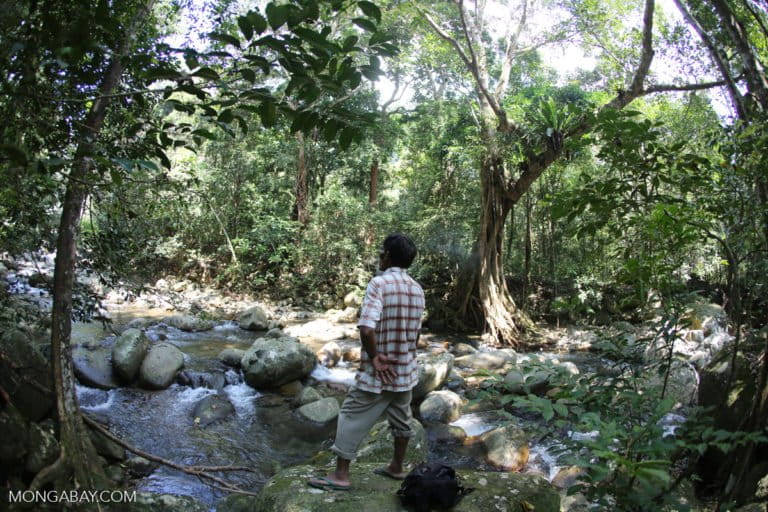
Indigenous peoples and conservation
Recognition of the role local and indigenous communities have in stewarding forests continued to grow in 2018. More reports and studies argued that securing indigenous peoples’ land rights is one of the most cost-effective mechanisms for protecting forests and mitigating climate change. Accordingly, philanthropic attention and dollars shifted toward such efforts, including a pledge by group of 17 philanthropic foundations at the Global Climate Action Summit to support recognition of indigenous peoples’ and traditional communities’ collective land rights and resource management as part of their land-based climate change mitigation programs. A study co-authored by UN Special Rapporteur on the rights of indigenous peoples and the Rights and Resources Initiative (RRI) even put a dollar figure on the labor and cash indigenous peoples invest in forest conservation efforts, estimating the annual contributions of such “Forest Guardians” at $1.7 billion.
Launched in 2017, the Interfaith Rainforest Initiative held gatherings bringing together religious and indigenous leaders, as well as scientists and policymakers, to discuss ways to build constituencies and partnership to protect forests.
24 countries in Latin America and the Caribbean agreed to a set of principles to protect environmental defenders, promote transparency in public access to environmental information, and improve environmental democracy and justice. The Escazú Agreement must now be ratified by the member countries. Latin America has been particularly hard-hit by murders of indigenous rights and environmental defenders in recent years, with Brazil, Colombia, Peru, and Mexico among the deadliest in 2017, according to Global Witness.

Ecosystem services: “Rivers in the sky”
The concept of forests driving “rivers in the sky” gained wider traction in 2018 thanks to a growing body of evidence showing the role tropical forests play in generating local and regional precipitation.
Research published in the journal Nature Sustainability estimated that the Amazon contributes as much as $8.2 billion to Brazil’s economy annually via the ecosystem services it affords.
Yet another study linked malaria to deforestation.
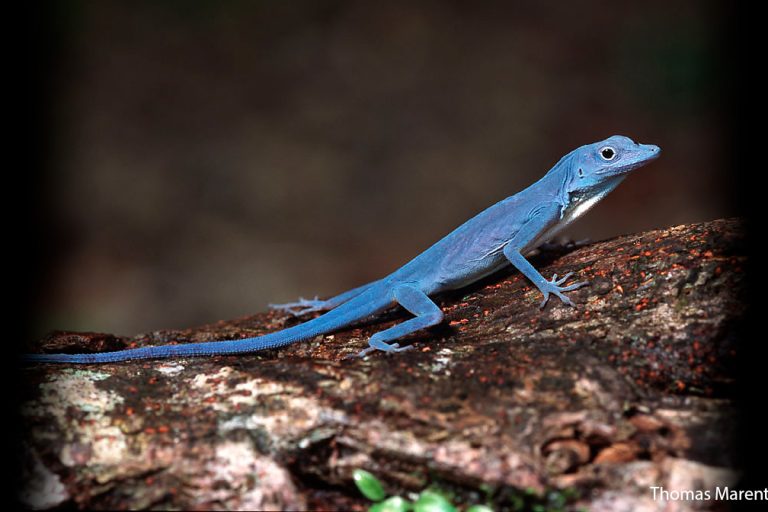
Colombia
25 young Colombians, ranging in age from seven to 26, filed a lawsuit against the government in January for failing to protect their right to a healthy environment. In April, Colombia’s highest court agreed, ordering the government to take immediate action to conserve forests and fight climate change. In its decision, the Supreme Court cited rising deforestation in the Amazon rainforest and granted “personhood” to the Colombian Amazon, giving it rights under law. Shortly after the ruling, Colombia’s then-president Juan Manuel Santos announced a plan to add 8 million hectares (80,000 square kilometers) to its protected areas and signed a decree granting indigenous communities more autonomy in governing their own territories. Norway committed $250 million in support of the effort.
The Colombian government scrapped a plan to complete the Marginal de la Selva highway due to concerns over deforestation and other environmental impacts. The road would have connected Venezuela to Ecuador through Colombia, but would have run near three national parks. President Santos also announced that Chiribiquete National Park would be expanded by 1.5 million hectares to 4.3 million hectares, making it one of the planet’s largest rainforest preserves. And in May, President Santos announced that five percent of the revenue generated from Colombia’s carbon taxes would go toward conservation projects under the Herencia Colombia program, effectively creating a new source of revenue for forest protection efforts.
But not all the news out of Colombia was positive for conservation in 2018. Observers continued to warn that Colombia’s peace agreement with the Fuerzas Armadas Revolucionarias de Colombia (FARC) could unleash deforestation as industrial agriculture moves into regions previously off-limits due to conflict. Indeed, satellite data suggests that deforestation and the incidence of fire has increased since the ceasefire was signed in 2016. For example in Meta, one of the departments where conflict was rife, Tinigua National Natural Park lost 3 percent of its forest cover in just three months. And lastly, in August President Santos left office with a low approval rating, raising uncertainty on whether his successor would be as strong a proponent for conservation.

Congo Basin and beyond
Democratic Republic of Congo (DRC) reopened logging across thousands of square kilometers of its rainforests, including granting concessions covering 6,500 square kilometers to two Chinese companies. The move ended the official logging moratorium that was put in place in 2002. In protest, more than 50 conservation and human rights organizations called on international donors to halt forest conservation-related funding to the country. A Greenpeace investigation suggested a further 14 concessions were slated to be granted and that large areas inside Salonga and Virunga national parks would be reclassified to allow extraction activities. Norway, which is a major funder of forest conservation across Congo Basin countries including DRC, voiced concern. Congo’s largest peatland was said to be at risk.
Following a kidnapping of two British tourists and in the midst of ongoing violence against rangers, Virunga, arguably Central Africa’s best known national park for its population of mountain gorillas, closed to visitors in June. In the wake of the closure, deforestation increased within the park’s boundaries. However in a bit of good news for wildlife, a survey showed that the population of mountain gorillas continues to rise, while a broader assessment found more lowland gorillas and chimpanzees than expected. The International Union for Conservation of Nature (IUCN) changed the status of mountain gorillas from “critically endangered” to “endangered”, citing population gains.
In May DRC officials established a new community forest strategy, which led to five communities winning legally recognized control of their forests for the first time. The community concessions covered some 300 square kilometers in Equateur province. NGOs involved in the process said that recognizing local people’s rights would help better safeguard Congo’s forests. The Rights and Resources Initiative (RRI) said that DRC wouldn’t be ready to implement REDD+ projects until issues around the rights of communities and indigenous groups were worked out.
A study published in the journal Area concluded that the Chinese furniture sector is a major driver of logging in Central Africa. Many of those products end up in the hands of consumers in the United States and Europe. Another study disaggregated drivers of deforestation in the Congo Basin and estimated that small-scale clearing accounts for 84 percent of tree cover loss. Selective logging was a distant second as a driver of deforestation, accounting for 10 percent of loss. The study warned that if current population forecasts prove accurate, the Congo basin could lose all of its primary forests by 2100. While most deforestation is driven by subsistence agriculture at present, NGOs warned about the threat to DRC and Congo Basin forests and indigenous peoples from planned expansion of industrial rubber, timber, and palm plantations.
Deforestation for industrial plantations continued to be a flashpoint in Cameroon. And a newly described species from Cameroon — based on a collection made nearly 70 years ago — may already be extinct due to habitat clearance.
Sierra Leone suspended timber exports over deforestation concerns.
Golden Veroleum Liberia, a palm oil company controlled by an Indonesian family, continued to be scrutinized for its operations in Liberia.
Republic of Congo created Ogooué-Leketi National Park as its fifth national park. Ogooué-Leketi, which covers 3,500 square kilometers and borders Batéké Plateau National Park in neighboring Gabon, is home to western lowland gorillas, chimpanzees, and forest elephants.
Other places
Madagascar: 2018 was a bad year for conservation in Madagascar. In the run-up to the presidential election, corruption around natural resources flourished and violence surged — including arrests of environmentalists and killings of conservation workers. Satellite data showed persistently high rates of deforestation — Madagascar had the world’s highest tree cover loss of any major forest country in 2017. Then in December, Madagascar elected Andry Rajoelina who during his 2009-2014 presidency presided over large-scale pillaging of Madagascar’s wildlife and forests, delivering serious set backs to conservation efforts on the island.
Malaysia: In early 2018, Sarawak committed to preserve 80 percent of its land area as primary and secondary forest, a surprising move given that less than 60 percent of the state is currently forested and plantation concessions amounted to a third of Sarawak’s territory in 2011. The announcement marked a major shift from the approach taken under the previous chief minister Abdul Taib Mahmud who orchestrated the plunder of Sarawak’s forests for timber and palm oil during his 33-year rule. However that wasn’t the biggest surprise in Malaysia this year: in May Prime Minister Najib Razak and his Barisan Nasional coalition were ousted from power after a corruption scandal. Najib’s replacement was Mahathir Mohamad, the 92-year-old former prime minister who presided over the birth of Malaysia’s palm oil industry but in recent years has become more critical of environmental degradation in the country. Mahathir immediately launched investigations into the infrastructure building spree Najib had undertaken. Several projects were suspended or cancelled. The election also impacted Sabah, Malaysia’s crown jewel in terms of rainforest biodiversity, with a new chief minister, Shafie Apdal, taking control after 15 years of rule by Musa Aman. Shafie removed Sam Mannan, who set aside vast blocks of Sabah’s rainforests for conservation, from his role as head of the Sabah Forestry Department. Shafie then banned log exports and ordered a review all timber concession holders. He also abolished communal land titles and hinted at opening up Sabah’s forests to coal mining.
Myanmar: Myanmar announced a crackdown on cross-border charcoal and timber trafficking and arrested a number of Chinese nationals allegedly involved with the trade. Logging mills decried the country’s 2017 timber export ban, while environmental activists complained about a “shadowy agreement” made by the Myanmar government to circumvent export restrictions for high value timber.
Japan: Activists from Rainforest Action Network (RAN) and other groups protested the use of rainforest timber from Malaysia and Indonesia for the construction of Olympic facilities. Japanese officials had earlier admitted that “at least 87 per cent of the plywood panels used to construct the New National Stadium” were from those countries’ rainforests.
Bangladesh: A number of press reports detailed deforestation and other degradation in Bangladesh resulting from the influx of Rohingya refugees escaping genocide in Myanmar.
Papua New Guinea and the Solomon Islands: Global Witness investigated illegal logging in Papua New Guinea and the Solomon Islands, finding that much of the timber goes to China.
Kenya: In February, the Kenyan government implemented a 90-day ban on logging in response to a severe water crisis. Indigenous forest peoples, including the Ogiek and Sengwer, continued to voice concern about eviction from their traditional lands in the name of conservation. The Yiaku pointed to their own stewardship as an example of best practice in managing forests.
India: The government released a new forest policy draft that environmentalists said placed too much emphasis on industrial timber. The government was also criticized for its claim that forest cover is increasing in the country.
Australia: The Australian government was widely condemned by conservationists and environmental activists for surging deforestation in Queensland and New South Wales. In March, the Queensland parliament passed stricter land-clearing rules.
Mesoamerica: The Belizean government approved the creation of one of Central America’s largest biological corridors with a 110-square-kilometer protected area that connects the Shipstern Nature Reserve and Freshwater Creek Forest Reserve in northern Belize. The effort was led by the Corozal Sustainable Future Initiative. Illegal forest clearing for cattle ranching was revealed in Honduras and Mexico.
Ecuador: The battle over oil in the Ecuadorean Amazon continued in 2018, with indigenous groups holding numerous protests against historical and planned extraction in eastern parts of the country. The issue was even put to a vote in a referendum, with Ecuadoreans deciding to expand the strictly protected portion of Yasuní National Park and reducing where extraction is permitted in the park, which is world-renowned for its high levels of biodiversity and as a refuge for traditional indigenous peoples. Later in 2018, the Constitutional Court of Ecuador ordered Chevron to pay $9.5 billion in compensation for environmental damage caused by Texaco, a subsidiary, between 1964-1990. The decision came almost 25 years after 30,000 people sued the company. Chevron, which has engaged in a long-running public relations and legal campaign against the plaintiffs, can no longer make appeals in the case in Ecuador.
Cambodia: 2018 was another year of violence against journalists and environmental activists in Cambodia. Investigations turned up examples of deforestation and illegal logging in Cambodian parks like Virachey National Park. In the run up to the general election in July, Prime Minister Hun Sen blamed the opposition and foreigners for these activities, while cracking down on press freedom, including effectively forcing the sale of the Phnom Penh Post to a PR firm.
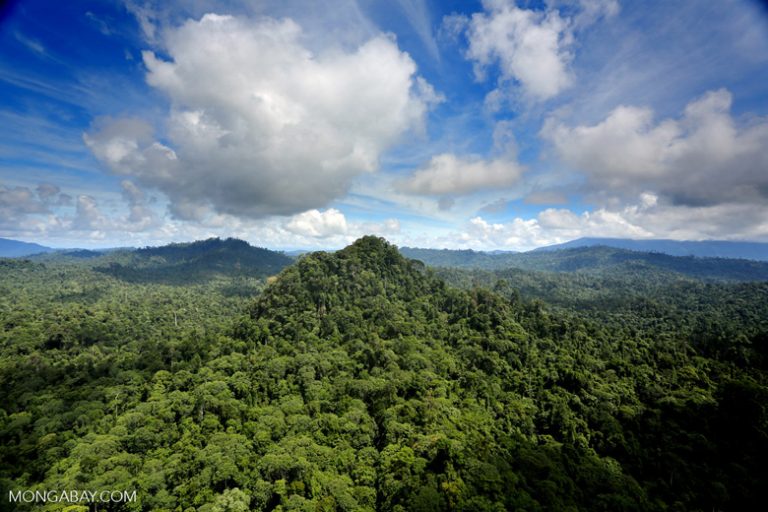
Global Rainforest Ecology
There were several major updates on the quality and extent of tropical forests as well as what’s driving deforestation.
An update of the global tree cover dataset that underpins platforms like Global Forest Watch came in June. It showed that we lost an area of tree cover equivalent to the land mass of Bangladesh in 2017, 158,000 square kilometers (15.8m hectares). Brazil led the tropics in terms of area of tree cover loss at 4.5m hectares, followed by DRC (1.5m ha), and Indonesia (1.3m ha). Total tree cover loss was the second worst on record (since 2001), following 2016.

A separate study, published in the journal Nature compared 2016 figures from the dataset with 1982. It found that while tree cover increased globally over the past 35 years, the planet’s most biodiverse ecosystems — especially tropical forests — lost vast areas of tree cover. The researchers in the Nature study broke land cover into three categories: tall vegetation consisting of trees of at least five meters (16 feet) in height; short vegetation under five meters in height including shrubs, grass, and agricultural crops; and “bare ground”, including urban areas, sand, tundra, and rock. While the classification may seem simplistic, powerful conclusions can be drawn from the data, including assessing agricultural expansion, climate-driven expansion and contraction of ecosystems, and forest clearing and recovery.
A third major study using the baseline dataset — published in Science — assessed drivers of tree cover loss between 2001 and 2015. It concluded that commodity-driven deforestation accounted for 5 million hectares per year or 27 percent of all forest loss, followed by forestry (26 percent), shifting agriculture (24 percent), and wildfire (23 percent).
And finally a fourth study based on the dataset said that deforestation in the highlands of Southeast Asia was much higher than previously thought.
On a much more micro-level, an investigation linked surging Chinese demand for avocado to deforestation in Mexico.
Several studies looked at characteristics of trees and forests that better withstand droughts, finding that taller and older trees fare better during Amazon droughts, while diverse forests are more resilient.
2018 featured a renewed focus on intact forest landscapes (IFLs), including a high-profile perspective published in Nature Ecology & Evolution that highlighted “the exceptional value of intact forest ecosystems“. A report issued by the World Wildlife Fund (WWF) and Wildlife Conservation Society (WCS) looked specifically at the threats from extractive industries to the 5.2 million square kilometers of tropical IFLs left globally, noting that nearly a fifth of this area is potentially threatened by extractive activities. Another study examined large-scale infrastructure projects in the Andes-Amazon region of South America and determined that the area around these roads and dams experienced tree cover loss four times greater than areas without such projects. Another study in Science found that a third of protected areas on land are influenced by intensive human activity. To help address declining wilderness, philanthropist Hansjörg Wyss committed $1 billion to conserve 30 percent of Earth’s surface and seas by 2030 through his foundation’s Campaign for Nature.
Beyond protecting intact areas, 2018 saw a push for ecosystem restoration via mechanisms ranging from reseeding by drone to conventional reforestation programs, but one study published in Conservation Letters gave reason for tempering exuberance about the prospects of forest recovery. It found that regenerating forests in Costa Rica — which has been championed for the apparent recovery of its forests — are short-lived, experiencing deforestation rates of 2.2-3.5 percent a year following recovery.
A study published in Nature Geoscience added further evidence to the idea that the downfall of the Maya may have been environmental degradation. The research found lingering effects of ancient deforestation on present-day soil carbon in Mexico and Guatemala.
More research added to growing concerns about the ecological impact of rainforest dams.
A Conservation Biology study highlighted the importance of elephants for African forests.
The European Union beefed up its tough talk on deforestation, including curtailing the use of palm oil in biodiesel transport fuels. France said it wanted the E.U. to ban imports of commodities linked to deforestation — including soy, palm oil, timber, and beef — by 2030. Indonesia and Malaysia complained about discriminatory trade practices, but a report by the Rainforest Foundation Norway said that the climate action plans (“Nationally Determined Contributions”) of most major tropical forest counties are not sufficiently ambitious to achieve a goal of ending deforestation by 2030 as pledged under the New York Declaration on Forests.
A study concluded that urban forests store significant amounts of carbon.
A study published in Science Advances argued that children in developing countries have better nutrition when they live near forests. The reason? Kids living near forests have more diverse diets. However another study, based on research near a protected area in Madagascar, concluded that local communities weren’t being sufficiently compensated for the opportunity cost of forgoing access to the protected forest. In other words, the local communities were effectively subsidizing the REDD+ conservation project.
The conservation community continued to talk more about measuring the effectiveness of conservation interventions and strategies, including the need for more experimentation. Emerging out of Mongabay’s series on the issue was a Frontiers in Ecology and the Environment paper that found the absolute number of Google searches on conservation and biodiversity topics is rising, suggesting that climate change isn’t crowding out people’s interest in biodiversity.
That’s a wrap on rainforest news for 2018. The outlook for 2019 will be covered in an upcoming post. Thanks for reading.




